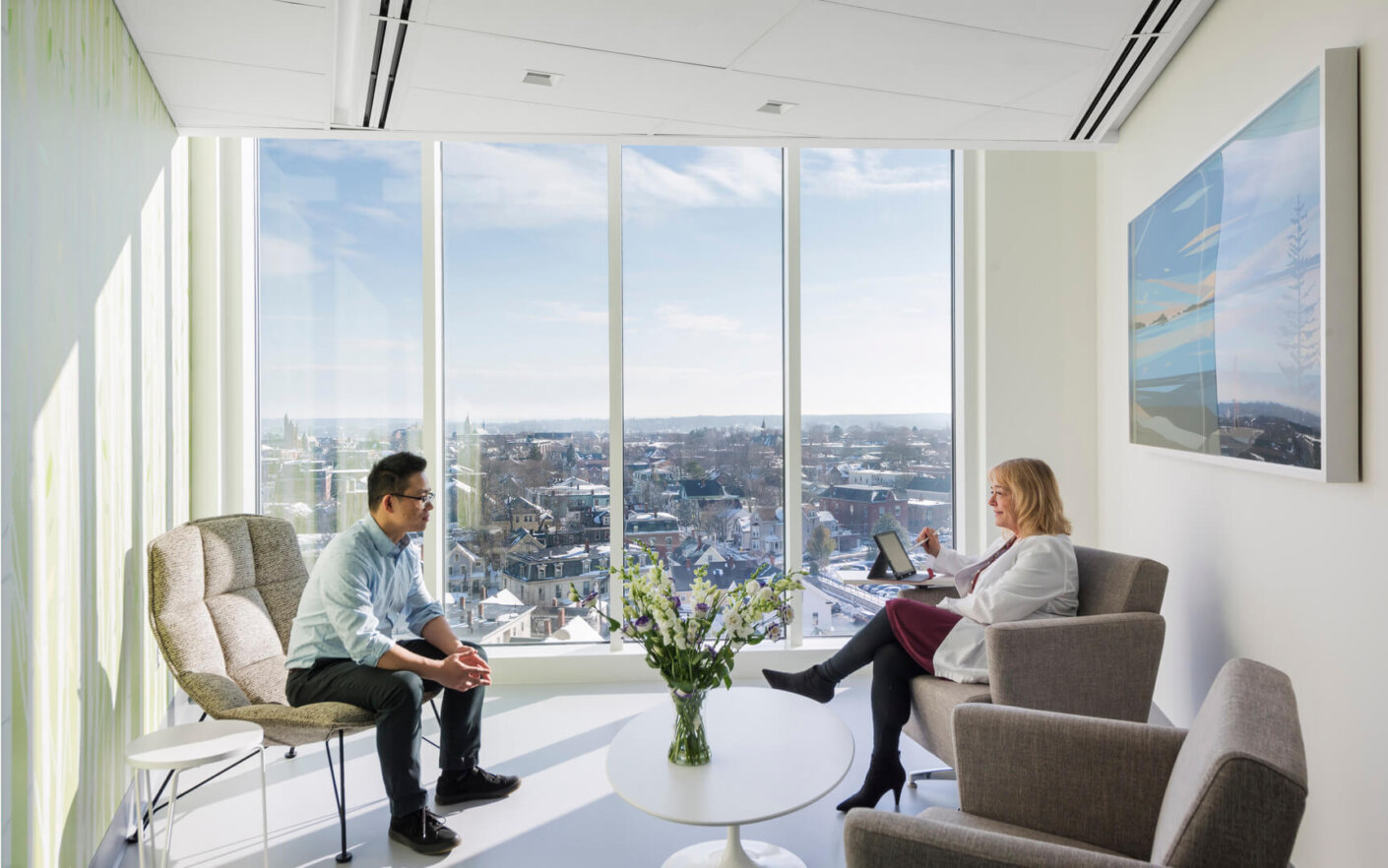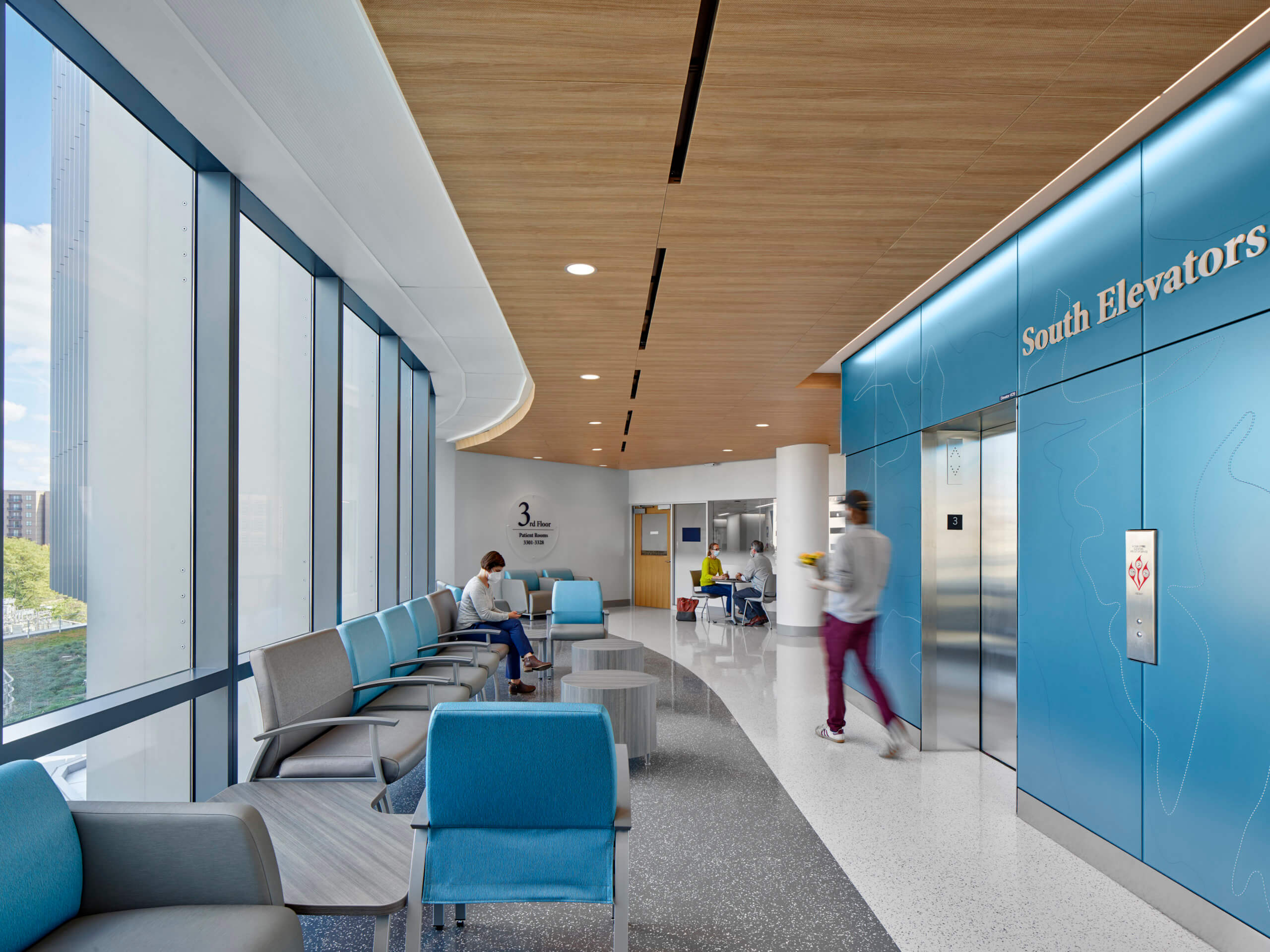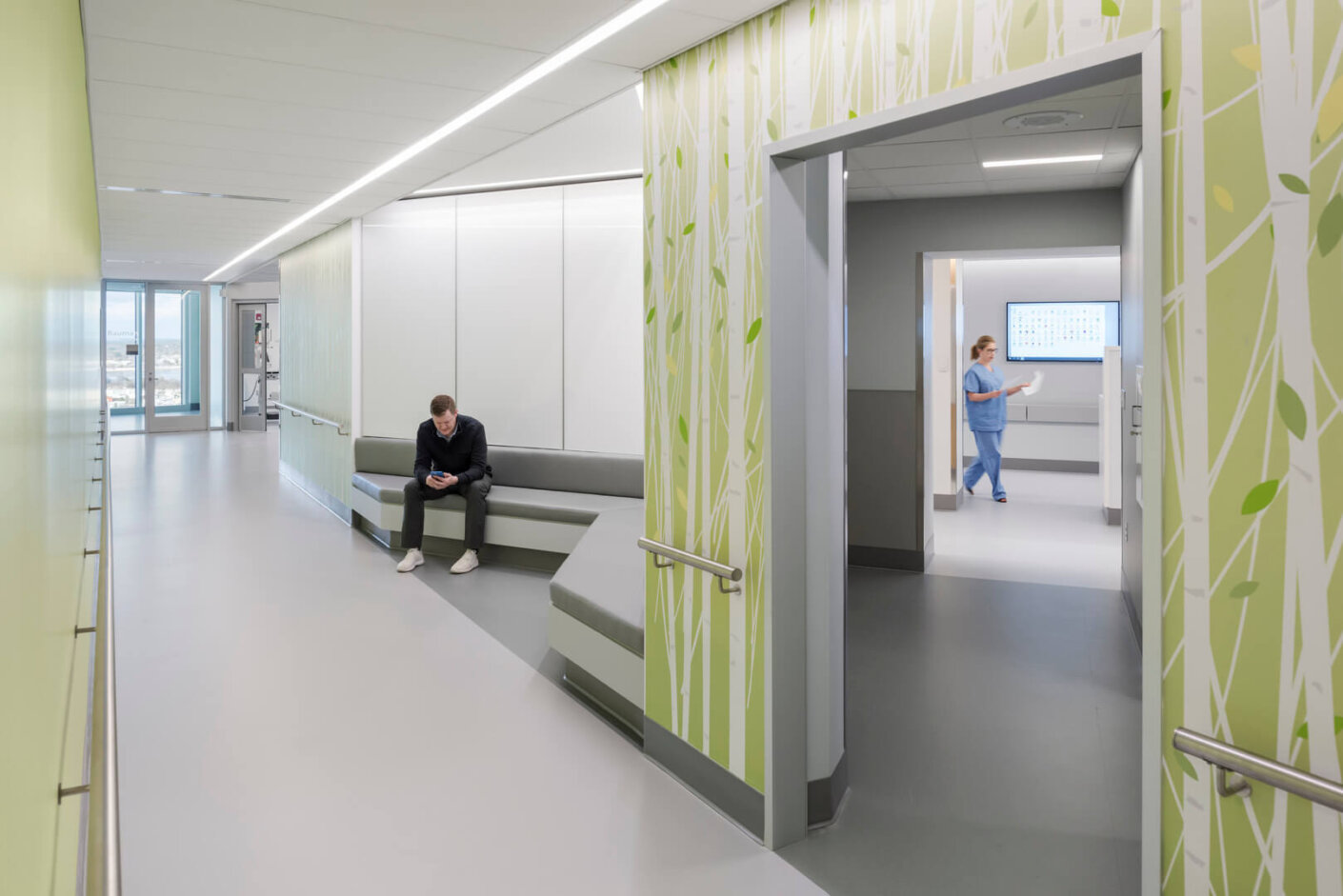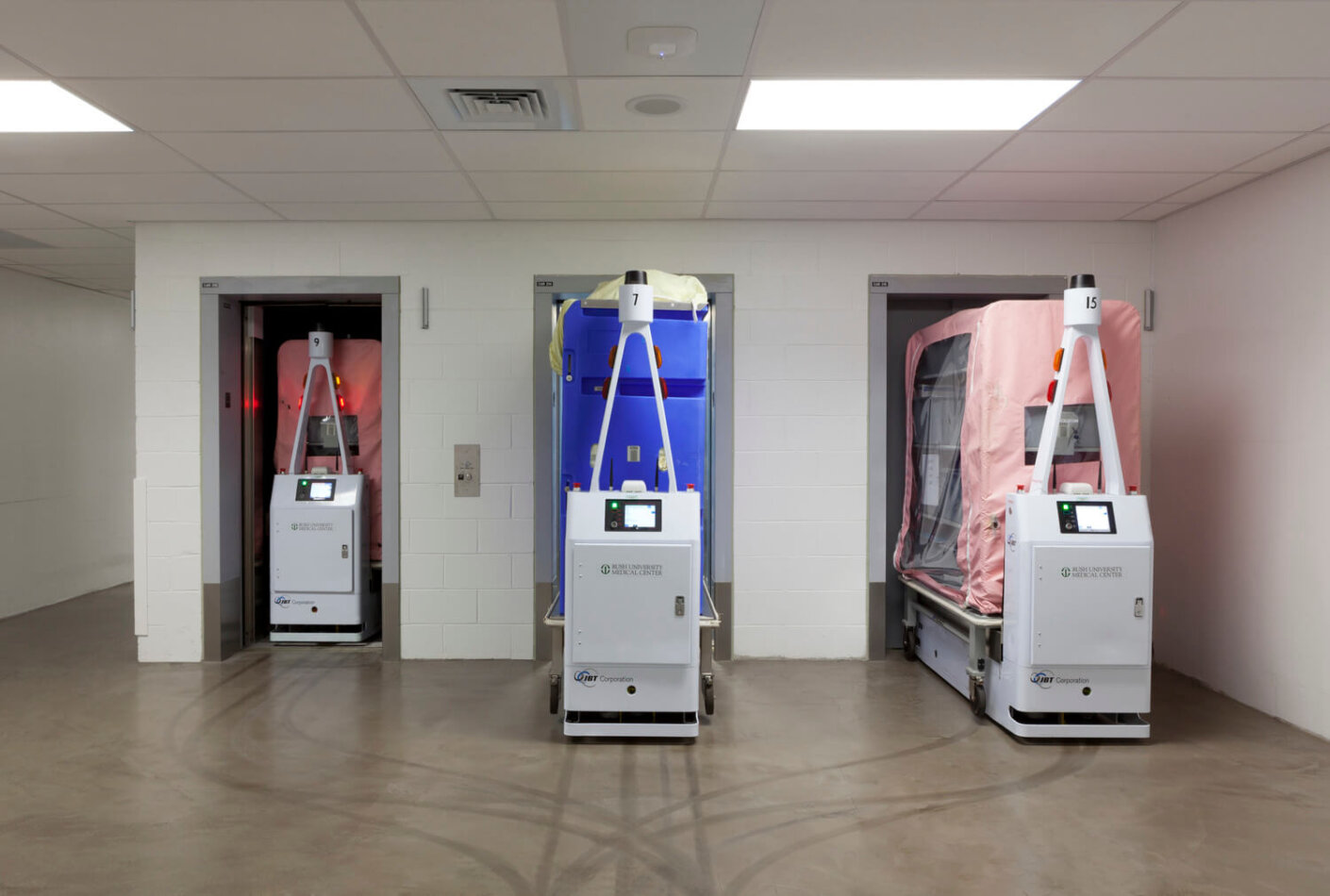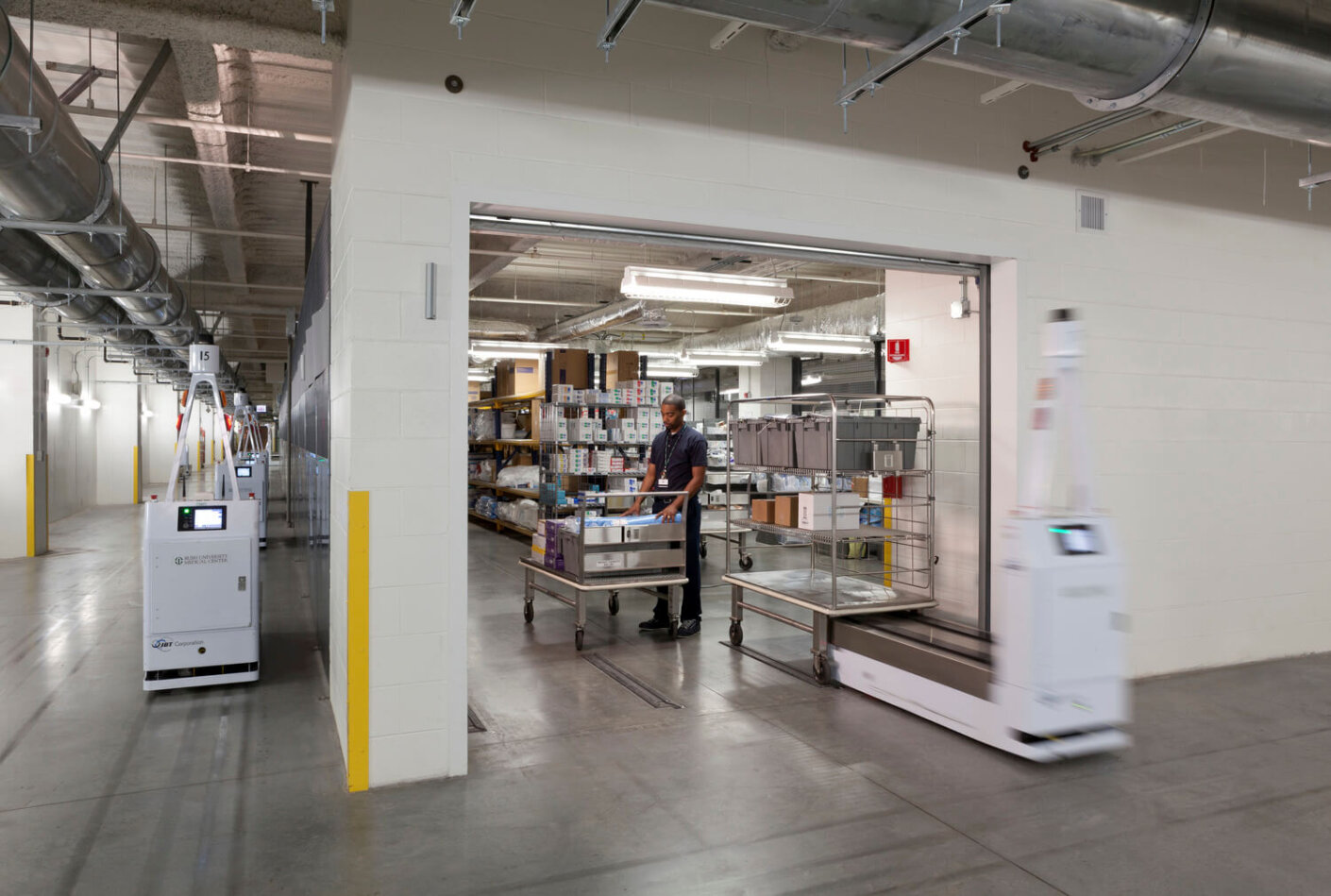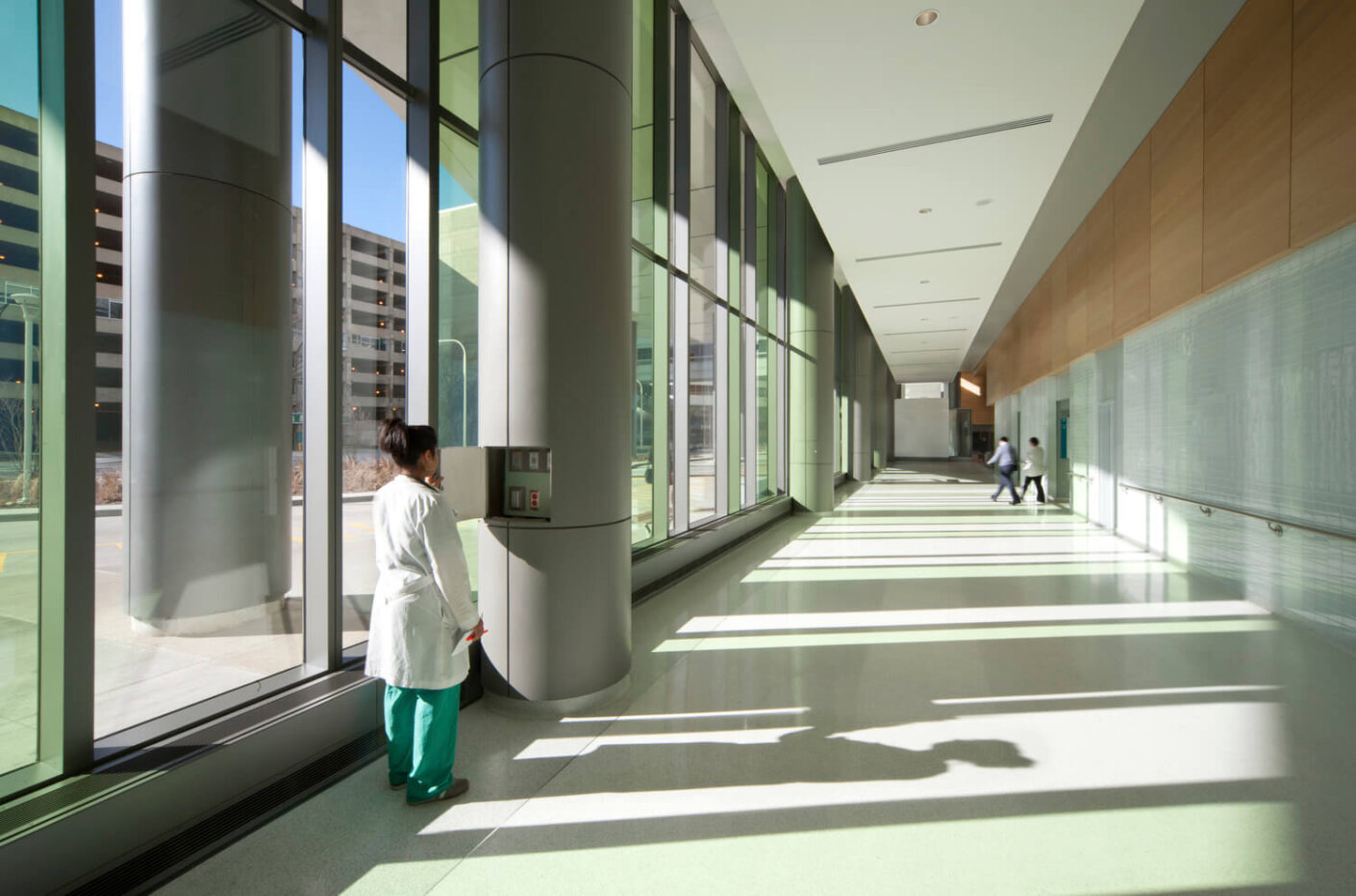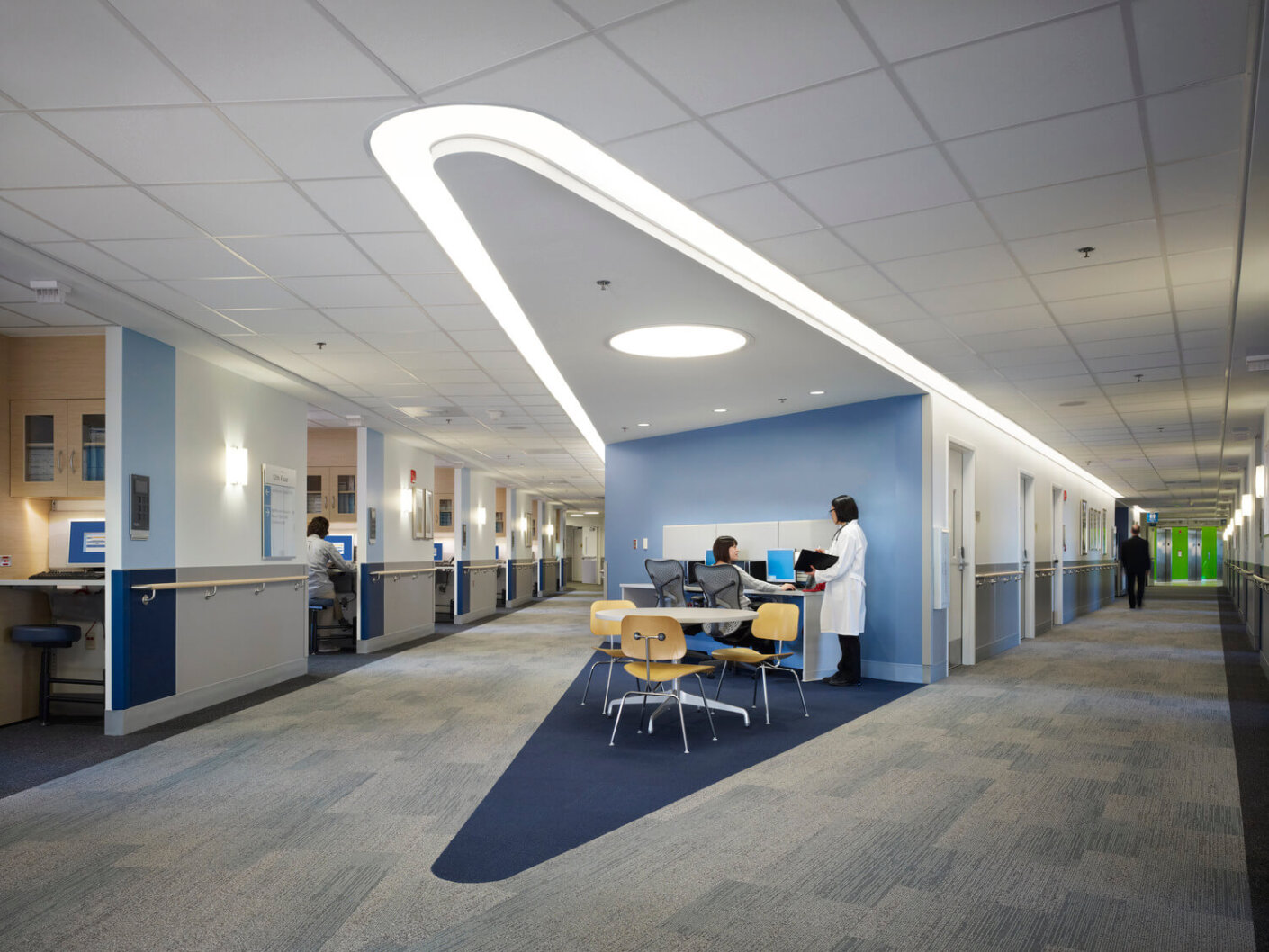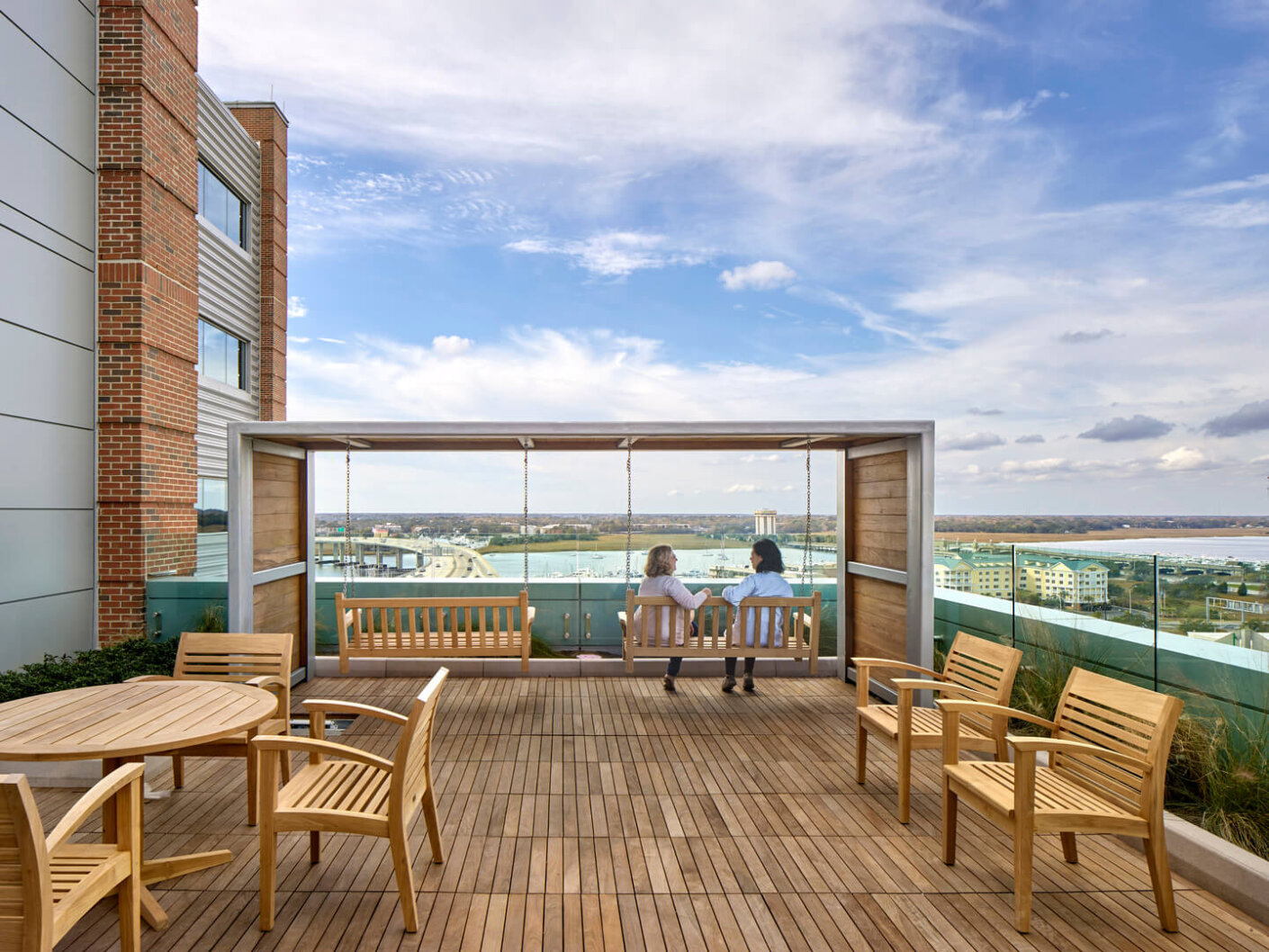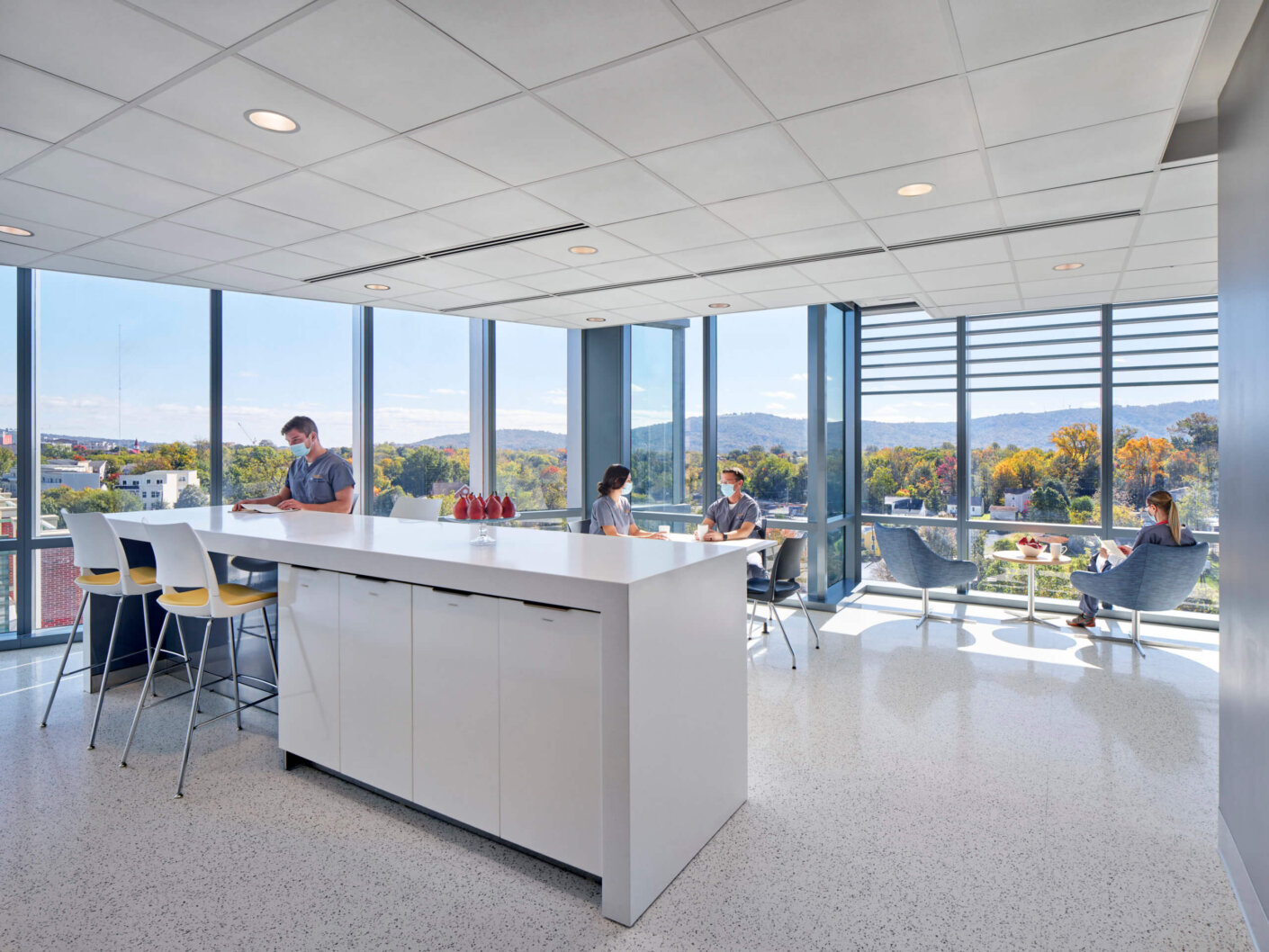We’ve learned a lot about healthcare design during the COVID-19 pandemic. The challenges healthcare workers continue to face are acting as catalysts for change, pushing design ideas and solutions that had previously percolated on the sidelines to the forefront of our work. Patient towers, in particular, have been top of mind for us and our clients, as COVID-19 has tested these environments’ surge capacities to the extreme. Today, there’s a clear need to reimagine what these facilities can, and should, do. Read on to learn more about our predictions for the patient towers of the future.
Creating for an Active Cure
Emerging research has shown the healing benefits of getting inpatients up and at ‘em, walking and exercising even after serious procedures. Patients who ambulate even just around their nearest corridors heal faster and lose substantially less muscle mass during the period of bed rest. While it may seem counterproductive to have our loved ones walking just days after surgery, the potential for positive outcomes of this kind of physical activity is changing the way we think about patient healing—and the spaces patients heal in, too.
Current healthcare design standards don’t always emphasize the value of open spaces in patient tower corridors, which are typically some of the busiest transition points in a hospital. We’re ready to change that. The patient tower of the future will have hallways wide enough for patients to pass arm-in-arm with nurses or family members, without feeling crowded by staff, visitors, and service traffic.
“We can’t be satisfied with creating a nice, private patient room when just outside the door we lose all the humanistic design,” says health practice leader Scott Davidson.
Improved design for mobility will also allow for resting points, like benches and chairs. These will be invaluable for inpatients who may need to catch their breath or suddenly stop before reaching their room.
“When thinking about which preexisting spaces can be improved now, I think first of these walkways,” says Robin Guenther, principal and health design leader. “It’s as simple as bringing in sturdy, comfortable seating that can be adjusted and relocated depending on any patient’s need.”
The need for this solution has become even more pressing since the advent of obligatory social distancing. We believe there are designs that can keep patients safe without sacrificing care delivery efficacy or comfort.
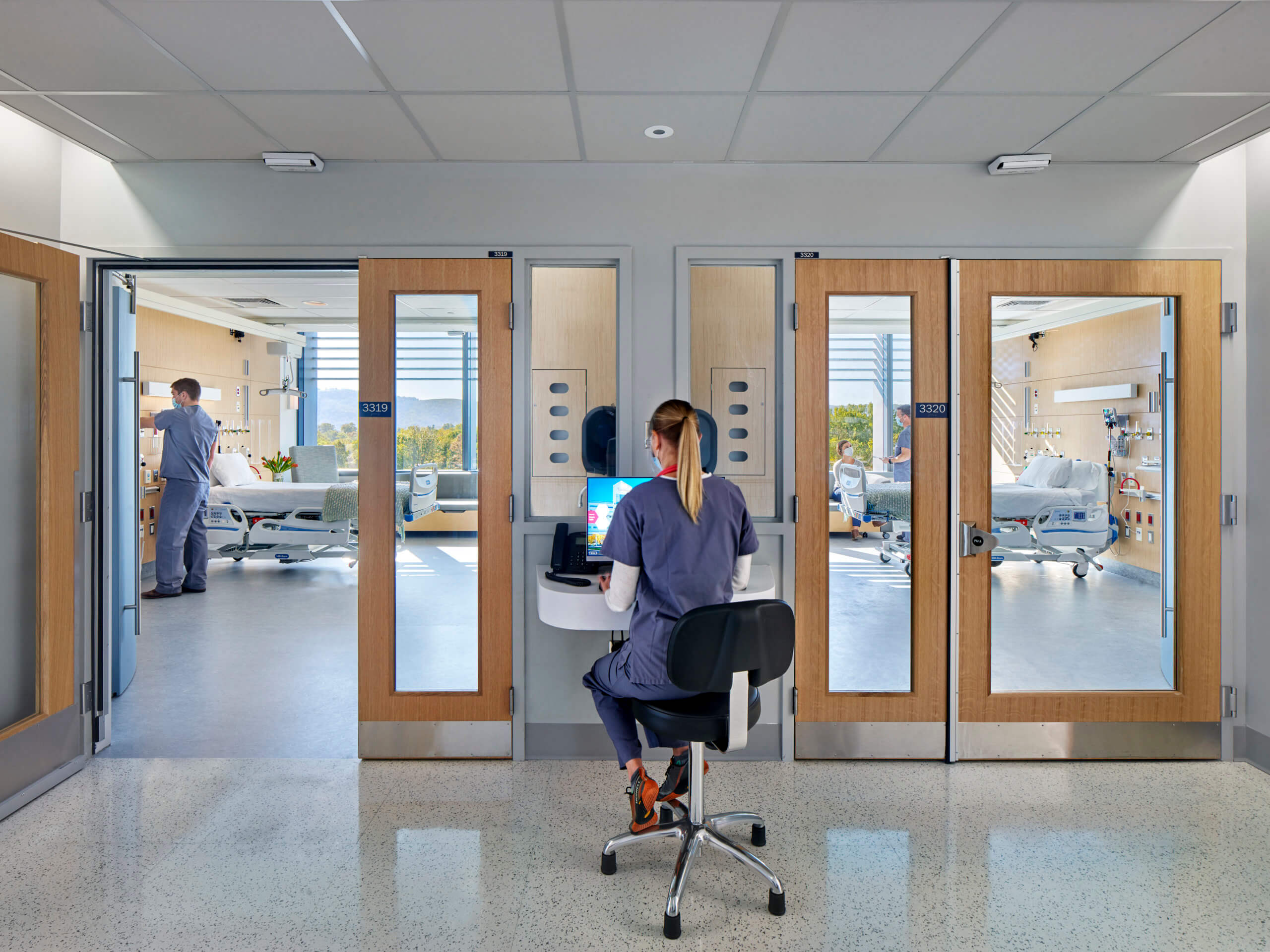
Realigning the Flow of Care
With corridors becoming more active, the need to address both the patient experience and that of nurses and caregivers comes to the fore. A crucial distinction will be designing for “front-of-house” versus “back-of-house,” or service versus serviced spaces. With the public corridor freed up entirely for mobility and team-based care delivery, we envision a whole new flow of circulation—one that allows patients to relax and heal, and allows caregivers to work in and around personal, organized workstations. Here, there is an opportunity for harmony.
Back-of-house spaces will keep resources, supplies, medication, and other life-saving materials close at hand. In addition to increased efficiency, this redesign will give nursing staff a space that’s customizable for their individual caregiving styles. By differentiating the needs of patient and caregiver, both parties can have a more seamless and optimized experience.
“This logical separation works to halt the spread of infectious diseases like COVID-19, but simultaneously, it also works to speed up the pace of healing,” says Davidson.
The Role of Technology and Robotics in the Delivery of Care
Solutions that improve the working conditions for frontline workers lead to better performance and reduced burnout for caregivers across the board, from assistants to surgeons. Robots, for example, can take doctors and nurses out of harm’s way while ensuring certain patient needs are met. Robots do not have the same emotional needs as people, so designing back-of-house spaces for machines to quickly and efficiently pick up, transport, and deliver resources and basic services to patients is much different than designing for staff.
By leveraging new technology, there is an opportunity to design for a more fluid and healthy experience for both patients and caregivers. Robotics and specialized patient and visitor management software are continuously creating safer environments in hospitals and patient towers, as well as fine-tuning communications so are more informed, and better suited to care and heal.
Besting the Bed Unit
In existing patient towers, bed units are often designed for efficiency rather than for hospitality. However, as we saw with the rise of COVID-19, bed units need to be able to accommodate more patients during surge events. In academic medical centers, the ability to flex between levels of acuity–acute to critical care–is increasingly important; sizing bedrooms for “universal” care needs prevents early obsolescence.
The COVID-19 bed crisis has shown us that it’s imperative, going forward, to equip other hospital spaces with the same features of the bed unit, including electrical outlets, tracks for hanging curtains, and easy access to nursing stations in order to manage patient surge. But in the patient tower specifically, this bigger-picture planning can allow us to keep bed units flexible and comfortable. In addition, we have also learned that caregivers can enter the room less often during a pandemic surge. Therefore, enhanced visibility between the corridor and patient is emerging as a key design factor. In practice leader Jean Mah’s words: “It’s time for a new, inclusive way of thinking about comfort. Standard design’s time is ticking.”
Rush University Medical Center in Chicago was conceived with surge in mind. The universal bedroom is the same for acute and ICU rooms, allowing for easy conversion between levels of care. In addition to the room size, we “designed for surge beyond the bed,” placing patient service outlets and other resources outside of the immediate unit, such as lobbies and corridors. This small decision became crucial during the coronavirus outbreak, as it allowed for power access even in overflow and large scale testing spaces.
An Indoor-Outdoor Workplace
The look and feel of a nursing unit is also set to be transformed given the rise in popularity of the “hotel” workstation model. Designed to support a nurse’s crucial ability to multi-task, this model combines the amenities for meeting areas with the resources to offer point-of-care delivery, too.
“Amenities can range from simple insertions like sit/stand desks to fully reinvigorated conference and break rooms,” says Amy Sickeler, a healthcare interior designer, “and throughout these spaces, we’re seeing an enthusiastic emphasis on ergonomics.” But there are also non-design related improvements for staff well-being that support our increasing emphasis on restorative break room design, including access to the outdoors, views, quiet and active zones. These design elements are supported by research on staff satisfaction and burnout, as well as recent lessons learned from COVID-19: these spaces for respite represent safe oases where nurses and staff can remove personal protective equipment (PPE) during a 12-hour surge shift.
The integration of outdoor spaces is also an invaluable design initiative supporting patient and staff well-being. The concept has its roots in the solariums of 19th century hospital design, but providing convenient outdoor access is reappearing as more evidence-based design research links access to nature with improved recovery times for patients. All the details that focus on the everyday experience of a staff member in our patient towers supports caretaking and healing for a patient, while helping hospitals reduce burnout and retain talent.
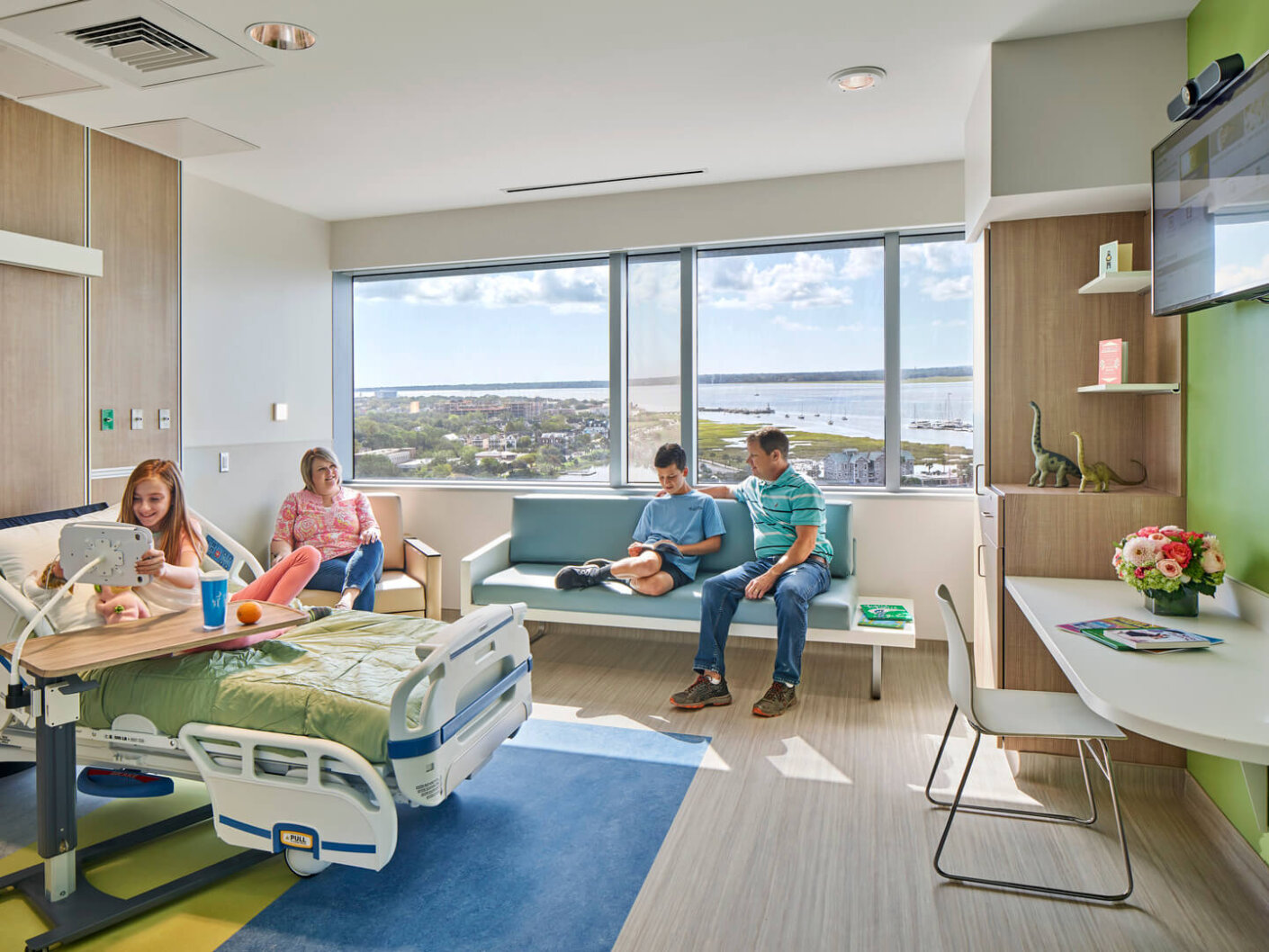
Sizeable Spaces for Healing
In the past, we’ve asked “how big is too big?” for a patient room. We consistently design bed units that are larger than the industry minimum requirement, believing that larger spaces allow for more flexibility in equipment and care delivery. In the aftermath of COVID-19, we now know that larger rooms that can flex acuity level over the life of the bed tower is a wise investment. As diagnostics become more portable, larger rooms can accommodate more tests and procedures, reducing patient transport from wing to wing and centralizing the delivery of care.
An emerging idea involves providing music and a variety of other audio during convalescence. Studies by E. Todd Wheeler Fellow Christopher Koss explored the benefits of music on healing and emotional recovery: In addition to inducing calm and relaxation, music can help drown out the omnipresent beeps, alarms and other sounds of medical equipment that can negatively affect patients’ well-being.
We took many aspects of our healthcare systems for granted before the COVID-19 pandemic. One was the expectation that no matter when or where, our hospitals will have a bed for us in which to rest, recover, and heal after anything from surgery to a broken bone. The stress of COVID-19 surges has left many without a bed, let alone a room, to rest and heal—a fact that threatens our sense of security and trust. By rethinking design priorities for spaces of recovery, though, the future of care and well-being is bright. Committed to innovating at every opportunity, we’re ushering in the next generation of patient-centric design.

